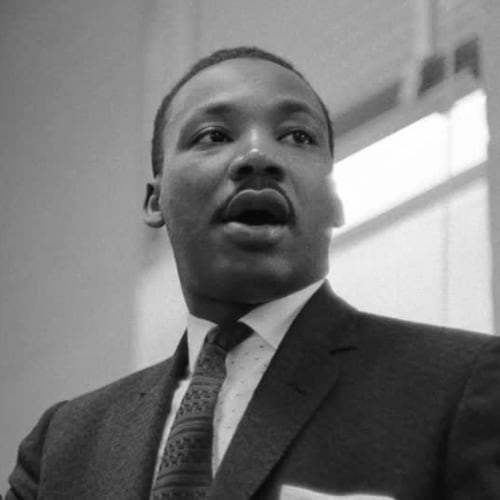Editor’s Note: This story is one in a series of Black History Month stories that explores the role of resistance to oppression in the Black community.
With all due respect to Gil Scott Heron, the revolution will be televised, and you’ll be able to spot the resistance by what they are wearing.
Fashion has played a role in civil discourse for ages, making the resistance instantly obvious from the mainstream. From the suffragettes wearing white in the early 1900s — repeated at the 2020 State of the Union address by female Democratic lawmakers — to the Black Lives Matter T-shirts of recent years, fashion has made a statement even when the resisters have been silent.
Credit: TNS
Credit: TNS
T-shirts are just the latest look in the resistance to inequality and oppression by the Black community and by advocates for other causes. Just the mention of black berets, leather jackets and dashikis conjures images of proud protesters during the 1960s and ‘70s. These aren’t the only iconic images, but they are a good jumping off point.
Credit: Curtis Compton / ccompton@ajc.co
Credit: Curtis Compton / ccompton@ajc.co
Black Panther ‘uniform’
Not long after founding the Black Panther Party for Self Defense, college students Bobby Seale and Huey P. Newton were watching a World War II film about the French Resistance.
“Inspired by the characters’ revolutionary zeal and style, one turned to the other and said, ‘Let’s wear berets, man,’” the Wall Street Journal wrote.
The berets were the final touch to the Panthers’ now iconic outfit of black leather jackets, blue shirts and sunglasses.
When asked about the headwear, Essence magazine reported, Newton said: “‘They were used by just about every struggler in the Third World. They’re sort of an international hat for the revolutionary.’'
Nearly 60 years later, the Panthers’ ensemble still evokes a feeling of Black pride and power. Who can forget Beyoncé’s 2016 Super Bowl halftime show, when — surrounded by dancers in black berets and leather outfits — she paid tribute to the Black Panther Party and other icons of Black history?
“I just have such gratitude for Beyoncé's bravery and her generosity,” former Black Panther Party member Ericka Huggins told Teen Vogue when asked about the half time performance. “I wish I could tell her. I wish there there was a way she would know that there are many members of the BPP who really appreciate her. I am just grateful to her for choosing to use her art for the upliftment of black people and humanity in general.”
Dashiki
Now available nearly anywhere, including Amazon.com, and worn by people of many races, the dashiki is an undeniably Western African garment.
Worn by both men and women, the dashiki became a symbol of resistance during the civil rights movement as a rejection of Western culture. Unlike the monochromatic and imposing outfits worn by the Black Panthers, the dashiki’s bright colors and patterns quickly became popular with Stevie Wonder, James Earl Jones, Wilt Chamberlain and other socially conscious Black people.
“I rock the dashiki because it represents the strength and lineage of African culture. And it’s fashionably fly,” Keinon Johnson, senior vice president of Interscope Records, told The AJC in 2015.
Credit: Michael Dodge
Credit: Michael Dodge
Resisting the norm on the court
Serena Williams resisted the adherence to the traditional cookie -cutter outfits of professional tennis. The fashinista and her sponsor, Nike, designed outfits that showcased the tennis player’s style and power.
Not everyone was on board with her choices — specifically, the French Tennis Federation. During the 2018 French Open, Williams wore a compression catsuit to help with blood flow six months after giving birth to baby Olympia. Fans loved it; the FTF did not.
“The outfit of Serena this year … will no longer be accepted. You have to respect the game and the place,” FTF president Bernard Giudicelli told Tennis magazine.
The 23-time Grand Slam champion followed that outfit with a three-piece ensemble with “champion,” ‘’queen,” ‘’goddess” and “mother” — in French — on the back of her warmup jacket. And just a few days later, she rocked a black tutu designed by friend Virgil Abloh, a backhanded shot at the French Open’s idea of feminism.
Credit: AP
Credit: AP
Black Lives Matter
Black Lives Matter wasn’t much more than a hashtag until George Zimmerman was acquitted in the shooting death of Trayvon Martin in 2012. Its mission, according to its website, “is to eradicate white supremacy and build local power to intervene in violence inflicted on Black communities by the state and vigilantes.”
The hashtag became a movement following three highly publicized police killings of Black men, and the same T-shirts worn by protesters during marches were soon seen on athletes and celebrities in a show of support.
As early as 2016, Atlantan Maya Moore and her WNBA Lynx teammates wore black T-shirts over their jerseys that read “Change Starts With Us. Justice and Accountability” on the front and “Black Lives Matter” on the back, Kurt Streeter wrote for the New York Times.
Now, anyone wanting to support the movement or at least appear like they do can buy clothing, jewelry, drinkware and more on Amazon, Etsy and the organization’s own online store.
These are but a few examples of how resisters set themselves apart from the crowd simply by what they wore. With new protests forming every day, keep an eye out for the common thread that identifies these groups and their causes.
ABOUT THIS SERIES
This year, the AJC’s Black History Month series will focus on the role of resistance to forms of oppression in the Black community. In addition to the traditional stories we do on African American pioneers, these pieces will run in our Living and A sections every day this month. You can also go to ajc.com/black-history-month for more subscriber exclusives on the African American people, places and organizations that have changed the world.
About the Author
The Latest
Featured






